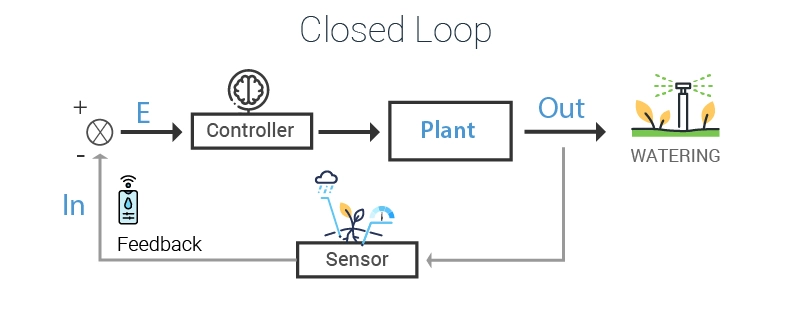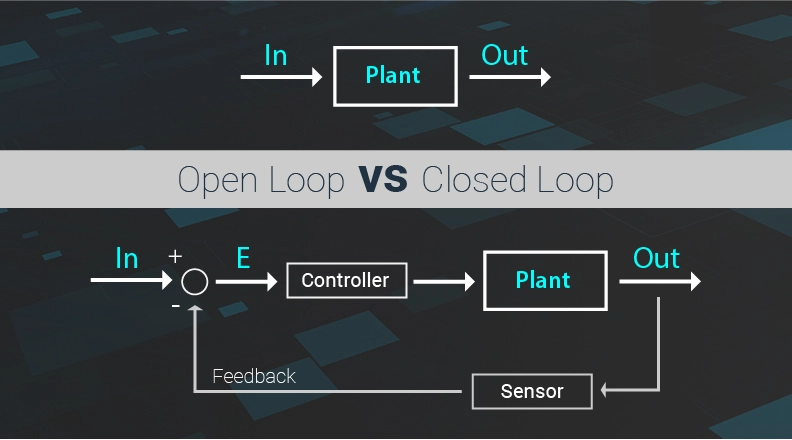Introduction to Open and Closed Loop Controls
Smart home devices, such as garden sprinklers and smart thermostats, enhance our comfort and convenience. These devices primarily operate on two methods: open loop and closed loop controls. We’ll explore the differences between these controls and their benefits. It’s important to note that the performance of IoT devices is significantly improved by their ability to communicate smoothly with each other and the internet. Whether employing open loop or closed loop controls, it’s their seamless connectivity that ensures efficient operation, making our smart homes even smarter. Let’s dive deeper into open and closed loop controls to understand their role in these smart IoT devices.
What is an Open Loop Control System?
Think about a garden watering system that turns on every day at the same time, like at 6 AM, no matter if it’s raining or sunny. This is an example of an open loop control. It’s easy to use and great when you don’t need things to be super exact or your looking for a lower cost option.

Key Components of Open Loop Control
Input: This is like a command you give. In our example, it’s telling the sprinkler to start at 6 AM.
Plant: This is the part that does what you told it to. In the sprinkler system, it includes the water, the sprinklers, and the part that turns the water on and off.
Output: This is what happens after. Here, it’s watering your garden.
What is a Closed Loop Control System?
Now, let’s think about that sprinkler system, but make it smarter. We add special parts like sensors that check things like how wet the soil is or if it’s raining. This is a closed loop system that uses feedback from the environment and feeds this data back as the new input.

Key Components of Closed Loop Control
Sensors: These check things like how much water is in the soil or if it’s raining.
Controller: This is like the brain. It looks at what the sensors say and decides what to do. If the ground is already wet or it’s raining, it tells the sprinklers not to turn on.
Input: The information from the sensors.
Processing: The controller thinks about the sensor info and decides what to do.
Output: What the controller decides to do. It can turn the sprinklers on or off.
Speaking of closed loop control systems for plant care, check out CEL’s Smart Plant Monitoring System Blog. This series of tutorials explains how to build a similar closed loop control system that utilizes sensors connected to CEL’s CMP40x0 ModuleCMP40x0 Module. It monitors the environment around plants and notifies you when watering is needed.
Benefits of Closed Loop Systems:
The closed loop sprinkler system is not only smart but also very practical. It saves water by watering the garden only when necessary. This smart system adapts to changing conditions, such as starting or stopping the watering based on whether it starts raining. It’s easy to manage too; once you set it up, it takes care of your garden all by itself, without needing constant attention. While it might be a bit more expensive to install initially, this system is a real money-saver in the long run because it helps conserve water and reduces the effort needed to keep your garden looking great.
Open vs Closed Loop in Real Life
Open Loop Systems Example
Dryer: They run for a set time, regardless of the moisture level in clothes.
Simple Irrigation Systems: These water plants on a timer, regardless of rain or soil moisture.
Closed Loop System Examplea
Smart Traffic Lights: They change their timing based on how many cars are waiting, helping reduce traffic jams.
Fitness Trackers: They check your heart rate and tell you if you should exercise more or less.
Factory Robots: They can change what they do based on what they sense, making them safer and better at their jobs.
Farming Drones: Some fly a set path over fields (open loop), but others can change their path based on what they see, like dry spots that need water (closed loop).
Integrating CEL into Your Smart Systems
Whether you’re developing a simple open loop system or an advanced closed loop control system, incorporating CEL’s connectivity modules can significantly enhance performance and reliability. Our modules are built from the ground up with RF characteristics in mind. This is incredibly important for each piece of either a closed loop or open loop system. Having a field sensor, particularly in a closed loop system, go offline can be catastrophic. Our best in class RF performance makes our modules the go-to for anyone looking to build a wireless control system for mission-critical data and systems
For more insights into how CEL’s solutions can transform your smart systems, visit Achieving Reliable Wireless IoT and explore our range of connectivity modules available.
Open Loop vs Closed Loop: Which Should You Choose?
Choosing between open loop and closed loop systems depends on how exact you need things to be, how much it costs, and what the job is. Open loop systems are simpler and more cost effective but offer less precision. On the other hand, closed loop systems prioritize precision and adaptability to changes.
When to Use Open Loop Systems
- When simplicity and low cost are priorities.
- When conditions are predictable (like scheduled watering).
When to Use Closed Loop Systems
- When you need precision (like smart thermostats).
- When conditions change frequently and sensors are available.
As we continue to innovate and interconnect various technologies, including the intergration of CEL's connectivity modules, these systems will further enhance our technological capabilities, seamlessly integrating into our daily lives and providing even greater assistance.




